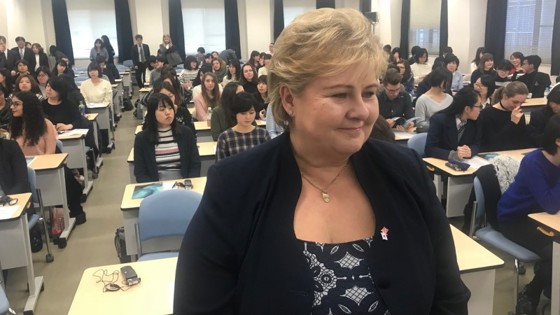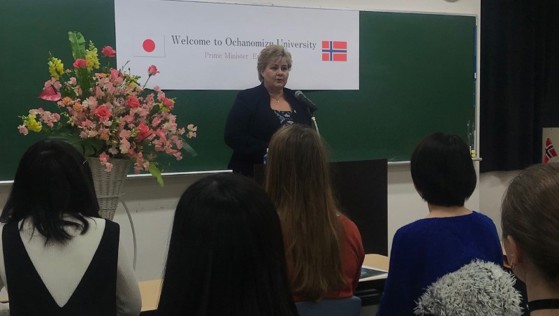Ochanomizu University
Historical archive
Published under: Solberg's Government
Publisher: The Office of the Prime Minister
Speech/statement | Date: 14/02/2018
Speech by Prime Minister Erna Solberg at Ochanomizu University in Tokyo, Japan, 14 February 2018.
Check against delivery

President, Vice Presidents, Professors and students,
It is a great honour to address you all here at Ochanomizu University. For more than 140 years, this university has provided female leaders to Japanese society: to academia, industry, politics and the media. You have a proud history – but also a crucial role to play for the future.
I welcome the close collaboration between Ochanomizu and the Norwegian University of Science and Technology. The cooperation agreement that was signed last year will ensure close research collaboration and many exchanges. This will benefit both universities, and will also strengthen the overall academic contact between our two countries. This is great news!
Promoting equal opportunities is a high priority for my government. We have come a long way in Norway, but, as is the case in Japan, challenges remain – and women still face obstacles.
Politicians, academics, the business sector and civil society need to come together to discuss how to improve female participation in the labour market, and how to ensure equal rights and non-discrimination. I know that this debate is very much alive in Japan, and I look forward to hearing your comments and questions on these topics.
Let me now share a few experiences from Norway:
When I was a student in the 1980s, Norway was seeing rapid changes in gender roles. A law allowing abortion on demand had just been past. The Gender Equality Act had been adopted. And Norway got its first female Prime Minister. Women were entering the labour market in great numbers. Equal pay and equal career opportunities were widely discussed. The issue of domestic violence was coming out from behind closed doors and becoming a political issue. Shelters for battered women were established. Norwegian society was beginning to change.
Women’s participation in the labour force has contributed tremendously to Norway’s growth and welfare. According to some reports, it has contributed more to our GDP than the oil from the North Sea.
So, how did we stimulate women’s entry into the labour market?
For many years, Norway has been investing in universal welfare programmes, including an extensive parental leave scheme.
- Today, parental leave is 49 weeks with full pay today.
- We have worked hard to provide sufficient day care for children.
- Flexibility in the workplace has helped people find a good work-life balance. In winter, many people in Norway leave work very early, so they can go cross-country skiing the same evening. And due to a flexible workplace they make up the time another day.
- We have also established the right to paid leave when a child is ill.
Due to these investments, Norway now has one of the world’s highest rates of female participation in the labour force. In the early 1970s, it was just below 50 %; and today 77 % of women work. However, challenges remain as many women still work part time.
When both parents are at work, the need for day care for children also increases. Over 90 % of all Norwegian 1-5 year olds are currently in day care. Full coverage for children in this age range is now secured by law.
Along the way, we have learnt that it is not enough to focus on women. If we want to ensure equality between women and men both in the family and in working life, we must strengthen the role of fathers. For the good of the children, and for the good of the parents themselves.
I understand that few Japanese men take parental leave, and if they do, it is often for a very short time. At the same time, important steps have been taken to encourage companies to enable men to take more leave. In Norway, the parental leave scheme has a quota that is reserved for fathers. As a result, a growing number of fathers are involved in childcare at an early stage. The rest of the parental leave may be divided between the parents as they wish.
But we did not stop there. In 2003, Norway introduced a quota for company: at least 40 % percent of the board members must be female. This goal was reached in 2008. But despite that achievement, there still has not been a significant increase in women at the top executive level in private companies.
On the other hand, we have a high proportion of female politicians. It all started when women gained the right to vote, in 1913. This gave women a formal foundation for taking part in democratic bodies on an equal footing with men. Since then women’s participation in democratic processes has gradually increased.
So how did this come about?
Most of the political parties had their own women’s committees and organisations. Some introduced quotas for women. Even parties that did not have formal quotas sought to achieve equal participation. More attention was given to gender issues, in particular women’s participation in the labour market, in political manifestos.
The question of whether introducing quotas is the best way to achieve gender equality is often discussed. On the one hand, quotas – both voluntary and statutory – have proven effective for creating a better gender balance. On the other hand, widespread gender equality has also been achieved without quotas.
Women have changed politics. Improving childcare, combating violence against women, and introducing legal abortion on demand are all changes that have mainly been championed by women. However, these developments have helped to unleash the potential of the whole population. They are not longer seen as women’s issues; they are part of the general political discourse. Male politicians are also involved in a much broader range of issues. Government ministers are expected to deliver on gender equality in the sectors they are responsible for. We must remember that we can never achieve full gender equality without engaging men.
Now a few words on the global outlook:
The need to enhance equal opportunities is still a key global issue. Giving women and girls the opportunity to succeed is the right thing to do; not only for the women and girls concerned, but also for the societies and economies they are part of. There is a clear link between efforts at national level and the adoption of the Sustainable Development Goals in 2015. This new agenda gives us a common roadmap to the future we want to build by 2030.
The 2030 Agenda is not a traditional development agenda. All countries – including Norway and Japan – are developing countries in this context. We all have work to do at the national level in order to reach the goals and targets on gender equality and women’s empowerment.
Ensuring equal education opportunities for girls and boys is a vital first step towards women’s and girl’s empowerment. Quality education paves the way for jobs and income. It is crucial if women are to hold political and economic power on an equal footing with men. This is why we have made girls’ education a priority in Norway’s development cooperation.
Equal rights and equal participation have their own inherent value, but they also benefit society as a whole. They are drivers of economic growth and development. We need to make use of all human resources in our countries, not just half of them.
The Sustainable Development Goals have energised the work for gender equality. We are seeing results at the global level. In healthcare and education, the gap is closing. However, there is still a huge gap between women and men in terms of economic participation and rights, and in terms of political empowerment.
There is still resistance to women’s economic participation in many countries. In a study of 173 countries, the World Bank has found that:
In 100 countries, women face gender-based job restrictions.
In 46 countries, there are no laws to protect women from domestic violence.
In 16 countries, men can legally prevent their wives from working.
These are examples on how concrete barriers, based on social norms, are hindering women’s participation. The sad fact is that countries that deny women their rights are preventing their societies from prospering.
A report from the McKinsey Global Institute in 2015 found that USD 12 trillion could be added to global GDP by 2025 by advancing women’s equality. The report also points out that the public, private, and social sectors all need to take action to close gender gaps. Other studies have estimated that raising Japan’s female labour force participation to the G7 average would increase per capita GDP by 4 %. If the gender gap was fully closed, per capital GDP could increase by nearly 13 %.
Estimates like these can always be questioned, but one thing is clear: in many countries women represent an underutilised resource. We have seen a positive development in Japan over the last years, but there is still potential for increased female participation in the labour force, and for many more women leaders.
As I’ve already said, we have made good progress towards gender equality in Norway. But gender discrimination still exists. We have a gender-segregated labour market. More women than men work in sectors with lower pay, even though more women than men take higher education. The number of women in part-time jobs is still a challenge. Many women from ethnic minorities do not work at all.
I am also deeply concerned about the issue of sexual harassment of women and violence against women.
So to conclude, each individual country must find its own way forward, but all countries must do their bit. Be it Norway or Japan. I will always stand by women and girls who are exercising their right to participate on an equal footing with men. It’s the only right thing to do; it’s also the most effective way of developing sustainable and prosperous societies.
I wish you good luck with your studies and your future participation in the Japanese society.
Thank you.
